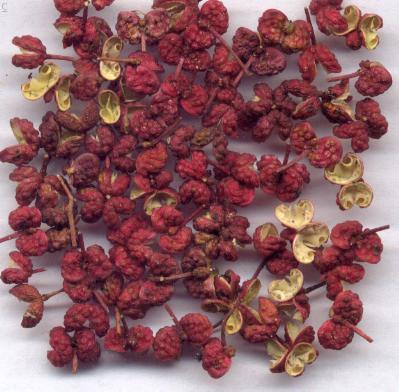Tibetan food, traditionally, does not have a lot of sweets and there are not a lot of naturally sweet ingredients in Tibet. However, there are a few. One sweet ingredient, unique to the himalayas, is droma. Droma is a sort of wild sweet potato. It is small, dark brown root, with a grainy texture and a mild and naturally sweet flavor similar to molasses. Droma is used in a few Tibetan sweets, especially Droma Dresi and Droma Markhu.
Droma is stored dried, and as a result can keep for several years. When my friend M and I prepared Droma Dresi this past weekend, we were using Droma that was well over a year old, and that's fine. However, it does mean that it requires special preparation.
Techniques vary, but most people recommend soaking the droma over night. Just put the droma in a bowl and pour water until it completely covers the droma, and then a little bit more. Leave this over night and the droma will be ready to use in the morning. Note that this is not ready to eat, just ready to use.
The simplest preparation of Droma, and the one most abhorrent to non-Tibetans, in Droma Markhu. Mar means butter, and Khu means clear soup or juice. Markhu, basically, means melted butter. So Droma Markhu is droma absolutely floating and drenched in melted butter and sugar. If you look at the top pictre, there is a dollop of sugared butter on top of the hot Droma, which will then be stirred in. To prepare Droma Markhu, just boile the droma for about 5-10 minutes until it has become tender enough to easily bite, but not soft. Mix butter and sugar. Dollop. Did I mention that Tibetan food is not heart friendly? Delicious though.
The most popular Droma desert is called Droma Dresi, or sweet rice with Droma. This is not only a desert, but a celebratory dish. If you attend religious festivities, a wedding, or any other big Tibetan special event, chances are the first thing that will happen is people going around passing out cups of bhoeja (Tibetan salt and butter tea) and droma dresi. Another fun fact: I have not yet met anyone, no matter how unfamiliar with Tibetan culture they were, that hasn't liked Droma Dresi. If you can't get droma, you could replace it with cubed yam or leave it out altogether. However, I think it's worth the effort to find it.
So, without further ado,
Droma Dresi
Ingredients:
3-4 cups of Basmati rice (really this depends on how many people you are serving)
a heaping handful of Droma
a handful of golden raisins
a handful of cashews
a cup of pineapple, cut into small bite-sized pieces (optional and not traditional, but I had it this way in Xining, Amdo, and fell in love with it)
sugar to taste
half a stick of butter (minimum!!!)
Pre-prep:
Soak the Droma overnight in room-temperature water. Drain before preparing.
Preparation:
-Prepare the Basmati rice according to instructions
-While the rice is cooking, soak the golden raisins in warm water for about 15 minutes
-Bring a small pot of water to a boil, boil the dresi for about 5-10 minutes or until tender enough to easily bite, but not soft enough to squish with your fingers.
-When the rice has about 5 minutes left and virtually all the water is gone, stir in the raisins and cashews
-Melt the butter completely
 |
| Droma Dresi (left) and Droma Markhu (right), a recent photo from Yushu, Kham |
Techniques vary, but most people recommend soaking the droma over night. Just put the droma in a bowl and pour water until it completely covers the droma, and then a little bit more. Leave this over night and the droma will be ready to use in the morning. Note that this is not ready to eat, just ready to use.
 |
| Soaked Droma |
The most popular Droma desert is called Droma Dresi, or sweet rice with Droma. This is not only a desert, but a celebratory dish. If you attend religious festivities, a wedding, or any other big Tibetan special event, chances are the first thing that will happen is people going around passing out cups of bhoeja (Tibetan salt and butter tea) and droma dresi. Another fun fact: I have not yet met anyone, no matter how unfamiliar with Tibetan culture they were, that hasn't liked Droma Dresi. If you can't get droma, you could replace it with cubed yam or leave it out altogether. However, I think it's worth the effort to find it.
So, without further ado,
Droma Dresi
Ingredients:
3-4 cups of Basmati rice (really this depends on how many people you are serving)
a heaping handful of Droma
a handful of golden raisins
a handful of cashews
a cup of pineapple, cut into small bite-sized pieces (optional and not traditional, but I had it this way in Xining, Amdo, and fell in love with it)
sugar to taste
half a stick of butter (minimum!!!)
Pre-prep:
Soak the Droma overnight in room-temperature water. Drain before preparing.
Preparation:
-While the rice is cooking, soak the golden raisins in warm water for about 15 minutes
-Bring a small pot of water to a boil, boil the dresi for about 5-10 minutes or until tender enough to easily bite, but not soft enough to squish with your fingers.
-When the rice has about 5 minutes left and virtually all the water is gone, stir in the raisins and cashews
 |
| Stirring in the raisins will plump them up |
-When the butter has melted, add sugar and hot butter together to the rice, then add the pineapple and droma and stir while still hot
-Taste and adjust sugar
And there it is! Droma dresi, a delicious desert and an important food for special occasions
 |
| Our finished product |


















